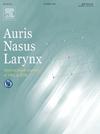中危甲状腺乳头状癌的治疗策略:重点关注肺叶切除术后甲状腺功能减退。
IF 1.5
4区 医学
Q2 OTORHINOLARYNGOLOGY
引用次数: 0
摘要
目的:中危甲状腺乳头状癌(PTC)的最佳手术方法尚未确定。手术方法应根据治疗效果和术后并发症来决定。本研究旨在通过比较甲状腺全切除术和甲状腺叶切除术的治疗效果和术后并发症,评估中危PTC患者的适当手术策略:这项回顾性分析针对2008年1月至2022年12月期间在我科接受治疗的123例中度风险PTC患者。PTC的风险根据日本内分泌外科协会制定的《2024年甲状腺结节临床治疗指南》进行分类:在123名患者中,27人接受了全甲状腺切除术,96人接受了甲状腺叶切除术。两组患者的存活率和复发率无明显差异。没有一名患者术后出现双侧喉返神经(RLN)麻痹。甲状腺全切除术组和甲状腺叶切除术组的术后单侧喉返神经麻痹发生率有显著差异,各为5例(分别为5.2%和18.5%;P = 0.04)。甲状腺全切除术组有两名患者(7.4%)出现永久性甲状旁腺功能减退。42例(43.8%)甲状腺叶切除术后患者出现甲状腺功能减退,其中32例需要使用左甲状腺素治疗。术前促甲状腺激素(TSH)水平(≥2.0 μIU/mL)与术后甲减之间存在明显关联(p < 0.001):接受甲状腺全切除术的中危PTC患者与接受甲状腺叶切除术的患者在治疗效果上没有明显差异。对于术前 TSH 水平≥2.0 μIU/mL 的病例,考虑到甲状腺叶切除术后需要服用左甲状腺素的可能性增加,全甲状腺切除术可能是更合适的方法。本文章由计算机程序翻译,如有差异,请以英文原文为准。
Treatment strategy for intermediate-risk papillary thyroid cancer: Focus on postoperative hypothyroidism following lobectomy
Objective
An optimal surgical approach for intermediate-risk papillary thyroid cancer (PTC) has not yet been established. The surgical procedure should be determined based on treatment outcomes and postoperative complications. This study aimed to evaluate appropriate surgical strategies for patients with intermediate-risk PTC by comparing treatment outcomes and postoperative complications following total thyroidectomy and lobectomy.
Methods
This retrospective analysis was conducted on 123 patients with intermediate-risk PTC treated in our department between January 2008 and December 2022. The risk of PTC was classified according to the 2024 Guidelines for the Clinical Treatment of Thyroid Nodules from the Japan Association of Endocrine Surgery.
Results
Of the 123 patients, 27 underwent total thyroidectomy, and 96 underwent lobectomy. No significant differences were observed between the two surgical groups in terms of survival or recurrence rates. None of the patients showed bilateral recurrent laryngeal nerve (RLN) palsy postoperatively. Postoperative unilateral RLN palsy occurrence differed significantly between the total thyroidectomy and lobectomy groups, with five cases in each (5.2 and 18.5 %, respectively; p = 0.04). Permanent hypoparathyroidism was observed in two patients (7.4 %) in the total thyroidectomy group. Postoperative hypothyroidism developed in 42 (43.8 %) lobectomy cases, with 32 requiring the administration of levothyroxine therapy. A significant association was observed between preoperative thyroid-stimulating hormone (TSH) levels (≥2.0 μIU/mL) and postoperative hypothyroidism (p < 0.001).
Conclusion
No significant difference in treatment outcomes was observed between patients with intermediate-risk PTC who underwent total thyroidectomy and those who underwent lobectomy. In cases with preoperative TSH levels ≥2.0 μIU/mL, total thyroidectomy may be a more suitable approach, given the increased likelihood of requiring postoperative levothyroxine administration following lobectomy.
求助全文
通过发布文献求助,成功后即可免费获取论文全文。
去求助
来源期刊

Auris Nasus Larynx
医学-耳鼻喉科学
CiteScore
3.40
自引率
5.90%
发文量
169
审稿时长
30 days
期刊介绍:
The international journal Auris Nasus Larynx provides the opportunity for rapid, carefully reviewed publications concerning the fundamental and clinical aspects of otorhinolaryngology and related fields. This includes otology, neurotology, bronchoesophagology, laryngology, rhinology, allergology, head and neck medicine and oncologic surgery, maxillofacial and plastic surgery, audiology, speech science.
Original papers, short communications and original case reports can be submitted. Reviews on recent developments are invited regularly and Letters to the Editor commenting on papers or any aspect of Auris Nasus Larynx are welcomed.
Founded in 1973 and previously published by the Society for Promotion of International Otorhinolaryngology, the journal is now the official English-language journal of the Oto-Rhino-Laryngological Society of Japan, Inc. The aim of its new international Editorial Board is to make Auris Nasus Larynx an international forum for high quality research and clinical sciences.
 求助内容:
求助内容: 应助结果提醒方式:
应助结果提醒方式:


